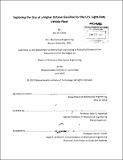| dc.contributor.advisor | John B. Heywood. | en_US |
| dc.contributor.author | Chow, Eric W | en_US |
| dc.contributor.other | Massachusetts Institute of Technology. Department of Mechanical Engineering. | en_US |
| dc.date.accessioned | 2013-10-24T17:33:20Z | |
| dc.date.available | 2013-10-24T17:33:20Z | |
| dc.date.copyright | 2013 | en_US |
| dc.date.issued | 2013 | en_US |
| dc.identifier.uri | http://hdl.handle.net/1721.1/81597 | |
| dc.description | Thesis (S.M.)--Massachusetts Institute of Technology, Dept. of Mechanical Engineering, 2013. | en_US |
| dc.description | Cataloged from PDF version of thesis. | en_US |
| dc.description | Includes bibliographical references (p. 64-67). | en_US |
| dc.description.abstract | This thesis explores the possible benefits that can be achieved if U.S. oil companies produced and offered a grade of higher-octane gasoline to the consumer market. The octane number of a fuel represents how resistant the fuel is to auto-ignition, which causes knock. By raising the octane number of gasoline, engine knock constraints are reduced, so that new spark-ignition engines can be designed with higher compression ratios and boost levels. In turn, engine and vehicle efficiencies are improved thus reducing fuel consumption and greenhouse gas (GHG) emissions for the light-duty vehicle (LDV) fleet. The main objective of this thesis is to quantify the reduction in fuel consumption and GHG emissions that can be achieved for a given increase in octane number. Engine modeling simulations in GT-Power are used to determine the relative brake efficiency gain (part-load) that is possible for a unit increase in compression ratio. This is found to be 1.9% while literature data suggests a 2.33%-2.8% efficiency gain may in fact be possible. Thus an average relative efficiency gain of 2.35% is assumed possible for a unit increase in compression ratio. Engine-in-vehicle drive-cycle simulations are then performed in Autonomie to determine an effective, on-the-road vehicle efficiency gain. For a compression ratio increase of 1.5:1, this results in a 4.7% efficiency gain for a downsized, naturally-aspirated, spark-ignition vehicle. If the vehicle is turbocharged, a 6.9% efficiency gain is possible due to additional boosting and further downsizing. With the possible efficiency gain determined at an individual vehicle level, a fleet model is then used to calculate the aggregate benefit for the LDV fleet by simulating the deployment and adoption rate of vehicles redesigned for higher octane gasoline. According to results from the model, roughly 69% of all LDVs on the road by 2040 will be of this high-octane variety that uses premium gasoline (98 RON). Meanwhile, premium gasoline is projected to account for almost 80% of the total gasoline demand by 2040. Ultimately by redesigning vehicles to take advantage of 98 RON gasoline, fuel consumption and GHG emissions for the fleet can be reduced by about 4.5% over the baseline case, where no high-octane vehicles are introduced. This reduction jumps to 6.0% if 100 RON gasoline is considered instead. | en_US |
| dc.description.statementofresponsibility | by Eric W. Chow. | en_US |
| dc.format.extent | 67 p. | en_US |
| dc.language.iso | eng | en_US |
| dc.publisher | Massachusetts Institute of Technology | en_US |
| dc.rights | M.I.T. theses are protected by
copyright. They may be viewed from this source for any purpose, but
reproduction or distribution in any format is prohibited without written
permission. See provided URL for inquiries about permission. | en_US |
| dc.rights.uri | http://dspace.mit.edu/handle/1721.1/7582 | en_US |
| dc.subject | Mechanical Engineering. | en_US |
| dc.title | Exploring the use of a higher octane gasoline for the U.S. light-duty vehicle fleet | en_US |
| dc.title.alternative | Exploring the use of a higher octane gasoline for the United States light-duty vehicle fleet | en_US |
| dc.type | Thesis | en_US |
| dc.description.degree | S.M. | en_US |
| dc.contributor.department | Massachusetts Institute of Technology. Department of Mechanical Engineering | |
| dc.identifier.oclc | 858865396 | en_US |
